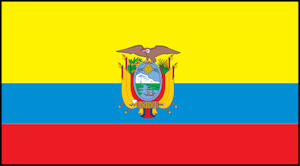Ecuador Flag Facts
-
Interesting Facts for Kids 1: Ecuador Flag
The National Flag of Ecuador was first introduced in 1835, and later again in 1860. However, the final and current version, whose design features the coat of arms of Ecuador, was officially adopted in 1900. -
Interesting Facts for Kids 2: Ecuador Flag
The flag of Ecuador can be described as a tricolour flag featuring three horizontal stripes which run yellow, blue, and red from top to bottom. The top, yellow band is double width and takes up half of the flag’s design. The blue and red bands are equally sized. -
Interesting Facts for Kids 3: Ecuador Flag
Ecuador uses both a civil and state flag. Unlike the state flag, the design of the civil flag does not incorporate the coat of arms. However, the state flag is commonly used, and allows the nation identifiable from its neighboring countries of South America. -
Interesting Facts for Kids 4: Ecuador Flag
The colors of the flag of Ecuador are meaningful and portray a true representation of its history, geography, culture and wealth. Yellow stands for Ecuador’s natural and mineral wealth, blue represents the ocean and skies, and red highlights the blood spilled during the country’s struggle for independence -
Interesting Facts for Kids 5: The Coat of Arms of Ecuador
The state flag of Ecuador can be identified by the coat of arms that lies central to its design. A representation of Mount Chimborazo features within the oval shield, with a river originating from its base, representing the Guayas River. The steamship, which can be seen on the coat of arms of Ecuador, is also named the Guayas, and was one of the first vessels build in Ecuador. Instead of a mast, the ship features a Caduceus, which represents trade and commerce. -
Interesting Facts for Kids 6: The Coat of Arms of Ecuador
Also featured on the Ecuadorian coat of arms is the sun which is symbolic of Ecuador’s pre-Colombian heritage, and the signs of the zodiac represent the months during which the Marxist Revolution occurred. The condor pictured on top of the coat of arms, with its wings outstretched, portrays the power and strength of the nation. The shield is surrounded by four flags of Ecuador. The laurel on the left of the coat of arms represents triumph of the republic, and the palm on the right side, represents the martyrs battle for freedom and independence. The Fasces (bundle of wood) below the shield symbolizes the dignity of the nation.
